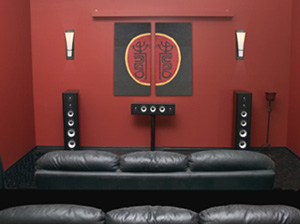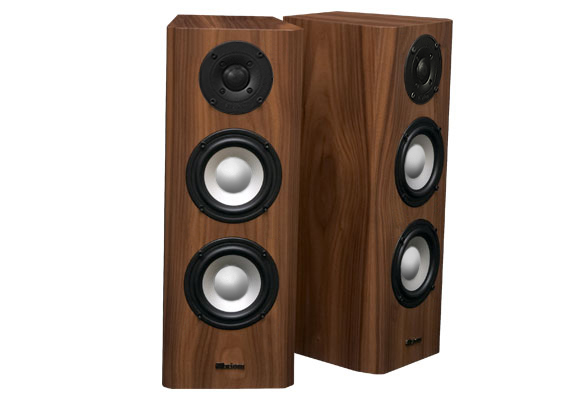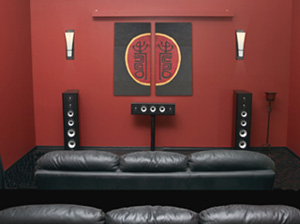By the 1930s, the scientists at Bell Labs (the scientific arm of the Bell Telephone system) understood that two channels were simply not enough, or were severely compromised, to convey a realistic simulation of an acoustic event.

The event the scientists designed their experiments around was a concert by the Philadelphia Orchestra, carried live over multiple long-distance Bell telephone lines to listeners in a remote location. Amazingly, this occurred in the era of mono, low-fidelity 78-rpm records, long before the invention of tape recording or two-channel (stereo) LP discs, which didn’t arrive until the early 1960s.
The scientists’ assessment at the concert’s end? They concluded that at the very least, a minimum of three channels were necessary to properly convey a reasonable facsimile of the orchestral performance. Two channels, they believed, were a major compromise, often resulting in an apparent hole in the middle, with no center image. This liability destroyed the illusion and collapsed the sound to the left and right speakers.
Which Illusion Do We Want?
But what are we seeking with this addictive hobby? A window looking in on a performance, with us sitting outside the window? Or the illusion of musicians playing live in our listening room? Is the medium supposed to transport us acoustically to the event, with all the original reflections and delays of the concert hall or club intact?

To get there from here, let’s back up a bit. By way of illustration, let’s say we set up a pair of stand-mounted Axiom M22ti’s (or a pair of M80ti’s) about eight feet apart, well out from the walls and facing straight out towards the listener. A few weeks ago, I did that, sitting in the center about 10 feet back from the speakers. I played a well-recorded CD that produces an excellent sense of front-to-back depth (on speakers with fine imaging and good lateral dispersion, that is). The disc (Ariel Ramirez: Misa Criolla, Philips 420 955-2) features a male tenor up front, miked up close, backed by a choir, South American and Spanish folk instruments, harpsichord, piano, and percussion, all positioned well back of the tenor and spread across the rear of the soundstage. It was recorded in a Spanish church, so there’s all kinds of reverberant information on the disc.
When I settled into my chair in the middle of the room, the illusion was very convincing. Jose Carreras, the tenor, is dead-center, on a plain even with the speakers, with the choir and folk musicians perhaps 20 feet behind him, arrayed across what seemed to be a fairly large acoustic space. When I closed my eyes, it seemed almost real: I was comfortably seated, looking in on this performance.
Yet, if I shifted my chair a foot or two left or right, the 3D soundstage, and the perspective of the singer, choir and musicians, more or less collapsed. Because the Axiom’s lateral dispersion of mids and highs is so good—I experimented with the M22ti’s and M80ti’s—even sitting to the side, I still retained a sense of a performance taking place in a large reverberant space, but much of the depth had disappeared, and the tenor and choir seemed offset to the nearest speaker. (A balance control can help compensate for this offset—but only a little.)
Why does this happen? Mostly, because the amplitude or loudness of sounds shifts to the speaker closest to our ears when we move away from the centralized "sweet spot." Our binaural hearing is cued to these amplitude and arrival-time differences so we can quickly determine the direction of sounds and voices. This ability was crucial in our evolution, so we could detect the approach of threatening beasts and enemies in the forest. But this same ability also fundamentally compromises two-channel stereo.
Big Two-Channel Flaw
The other flaw—and it’s huge—which intrinsically limits stereo’s ability to create the sense that we’re in the same acoustic space as the musicians is that all the reverberant information contained on a stereo recording is fired back at us from two speakers at the front of the room. If you think about it for a moment, it never happens that way live in a concert hall, studio, club, or arena. Yes, sound comes from the on-stage musicians directly to our ears (and to the two stereo microphones), BUT it’s also reflected from the side walls, the ceiling and the back wall, and reaches our ears from those directions a few milliseconds later. That tells our ears and brain the size of the acoustic space, the position of the musicians within that space, and our location relative to the musicians. And it’s the directions and delays of those reflected sounds that must be preserved intact—and replayed in your listening room from the same direction. That is what convincingly recreates the illusion of the hall and space. To be fair, two stereo channels will also register those reflected sounds, but they reproduce them from the front of the room, and that’s where the stereo illusion falters.
More than Two to Tango
So where are we now? It’s no surprise that decades after the Bell Lab experiments, when movie sound and Dolby Labs engineers were doing early work on multi-channel cinema sound, it seemed logical to add a center channel. (In cinemas, this was essential for audience members seated off to the side. Without a third-channel dialog speaker, behind the screen, the actor’s voices would shift to whichever side of the theater viewers were seated on.) So naturally, when Dolby Labs developed its first consumer version of Dolby Surround, they added not only the center channel but a matrix scheme to preserve and then derive the ambient and directional information contained in the two channels, which was then rerouted to side-mounted surround speakers. Although crude, at least the reverberant reflected sounds were aimed at your ears from roughly the same direction that might have occurred in the original concert space. Moreover, the surround signals were mono—played back over two surround speakers—but mono nonetheless, quite unlike what happens in real-life concerts. Still, it was a whole lot better and more convincing than two-channel stereo.
Now, of course, with Dolby Digital/dts, DVD-Audio, and Sony’s SACD, we have 5.1 discreet channels, with embellishments in some configurations. We can add QS Multipole surround speakers at either side, which simulate the dispersion of multiple relections in real-life concerts—and they are fed by separate channels that, in many of the best recordings, are used to record the actual direction, intensity, and delays of the real-life reflected sounds.
The Comparison
Back to our experiment. When I played the CD of Misa Criolla and the Spanish choir and folk musicians on my 5.1-channel surround system (with M22ti mains and QS surrounds), and listened in Dolby Digital Pro Logic, then DPL II, the recording opened up. I seemed to be almost in that old Spanish church. It was a big improvement on stereo, and enjoyable from numerous locations in the room, but still not quite ideal. That I experienced when I put on a remarkable DVD-Audio demo disc from AIX Records (www.aixrecords.com), which contains not only 96-kHz/24-bit 5.1-channel DVD-Audio recordings with selectable "audience" or "stage" point-of-view mixes, but Dolby Digital 5.1 tracks for compatibility and video content of the performances. Even if you don’t have a DVD-Audio player yet, I urge you to try out this disc (it’s available free for a modest shipping charge from the AIX Records web site). It’s compatible with any DVD player and the Dolby Digital 5.1 audio mixes are almost as good as the 96 kHz/24-bit DVD-A mixes.
Five Channels = Ultimate Realism?
What will you hear? On the sampler disc, I heard the most realistic jazz recording of a piano I’ve ever heard. The piano is right there, in my room! And an amazing recording of an a cappella vocal group, Zephyr, done in the round, simulates the listener standing in the center, with the singers encircling him or her. If you switch to the "audience" mix, it’s as though you’re sitting in the first or second row of a small recital hall. And when you play the track of Luis Conte’s Latin Jazz Trio in stereo, it’s good—but then switch to 5.1 channel discrete, and the sound of the conga "opens up," telling your ears you are right there in the studio. What’s so realistic and wonderful about these recordings is that you can move around your room to different seats, and the realism is retained. (Keep in mind I used Quadpolar surround speakers for these tests.)
So let’s "hear" it for multiple channels for audio. Five (plus .1) almost gets us to audio nirvana. More channels will only improve things further. But the Bell Labs guys would be astonished and delighted by what’s evolved in the 65 years since their first three-channel experiments.
In closing, I should mention that Tomlinson Holman, the guru of Lucasfilm’s THX system (he’s the "TH" in the name) has demonstrated 10.2-channel sound: I heard it, and it’s fantastic. But yikes, where to put all those speakers?






